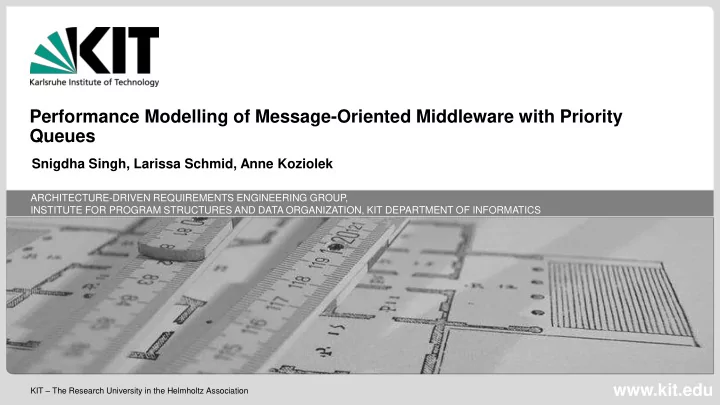

Performance Modelling of Message-Oriented Middleware with Priority Queues Snigdha Singh, Larissa Schmid, Anne Koziolek ARCHITECTURE-DRIVEN REQUIREMENTS ENGINEERING GROUP, INSTITUTE FOR PROGRAM STRUCTURES AND DATA ORGANIZATION, KIT DEPARTMENT OF INFORMATICS www.kit.edu KIT – The Research University in the Helmholtz Association
Message-oriented-middleware (MOM) Performance-relevant factors • Queue length • Queue durability • Queue latency • Queue message length limit Overview of the entities of the AMQ model 2 9 November 2020 Snigdha, Larissa and Anne- Performance Modelling of Message-Oriented Architecture-driven Requirements Engineering Group Middleware with Priority Queues Institute for Program Structures and Data Organization
Priority queue More processing delay of Increases the latency Reduces the performance high priority messages 3 9 November 2020 Snigdha, Larissa and Anne- Performance Modelling of Message-Oriented Architecture-driven Requirements Engineering Group Middleware with Priority Queues Institute for Program Structures and Data Organization
Motivation Can we model and simulate the MOM with priority queue with palladio component model (PCM)? • Event-extension approach extends the PCM model elements to predict the performance and quality attributes of MOM • Message-queuing-simulation approach further adds new model elements for modelling and simulation of MOM with PCM to predict the performance Idea • Propose possible extensions to existing PCM approaches to support performance predictions for MOM with priority queuing • Compare the proposed approach for delay of individual events at the subscriber end 4 9 November 2020 Snigdha, Larissa and Anne- Performance Modelling of Message-Oriented Architecture-driven Requirements Engineering Group Middleware with Priority Queues Institute for Program Structures and Data Organization
Research questions and Contribution RQ1 : What is the efficient way to model such MOM with priority queue using palladio component model (PCM)? • Which performance related metrices can be measured? C1: New model elements are added in message-queuing-simulation priority extension and event- extension priority extension to predict the performance of MOM with priority queue • Message-queuing-simulation priority extension approach is semantically more clearer • Queue length and queue latency 5 9 November 2020 Snigdha, Larissa and Anne- Performance Modelling of Message-Oriented Architecture-driven Requirements Engineering Group Middleware with Priority Queues Institute for Program Structures and Data Organization
Event-extension approach with PCM https://sdqweb.ipd.kit.edu/wiki/PCM_Event-Based_Communication 6 9 November 2020 Snigdha, Larissa and Anne- Performance Modelling of Message-Oriented Architecture-driven Requirements Engineering Group Middleware with Priority Queues Institute for Program Structures and Data Organization
Priority scheduling for event-extension approach Challenges • Messages are queued and processed at the resource level • Could not measure the individual queue length at the receiving end • The component can not consume from both priority and non-priority queue at the same time 7 9 November 2020 Snigdha, Larissa and Anne- Performance Modelling of Message-Oriented Architecture-driven Requirements Engineering Group Middleware with Priority Queues Institute for Program Structures and Data Organization
Message-queuing simulation approach with PCM 8 9 November 2020 Snigdha, Larissa and Koziolek- Performance Modelling of Message-Oriented Architecture-driven Requirements Engineering Group Middleware with Priority Queues Institute for Program Structures and Data Organization
Priority scheduling for message-queuing-simulation approach • Queue length can be measured • Priority queues can be modelled directly in the assembly view type instead of in the resource environment view type • Messages are processed in message broker in separate queues 9 9 November 2020 Snigdha, Larissa and Anne- Performance Modelling of Message-Oriented Architecture-driven Requirements Engineering Group Middleware with Priority Queues Institute for Program Structures and Data Organization
Comparison Parameters Message-queuing-simulation Event-extension new attributes number to EmitEven t action VariableCharacterisation to SendMessageAsync scheduling policy preemptive-priority scheduling available scheduling policy approach processing at resource level based on priority- in message-broker in separate number queues queue position outside resource container inside message broker individual queue length, queue latency performance metrics queue latency 10 9 November 2020 Snigdha, Larissa and Anne- Performance Modelling of Message-Oriented Architecture-driven Requirements Engineering Group Middleware with Priority Queues Institute for Program Structures and Data Organization
Conclusion Message-queuing-simulation priority extension will be much easier and semantically more clearer as compared to the event-extension priority extension Future Work Implement the Message-queuing-simulation priority extension with a real-world case study and measure the latency and queue length for validation 11 9 November 2020 Snigdha, Larissa and Anne- Performance Modelling of Message-Oriented Architecture-driven Requirements Engineering Group Middleware with Priority Queues Institute for Program Structures and Data Organization
Thank You! 12 9 November 2020 Snigdha, Larissa and Anne- Performance Modelling of Message-Oriented Architecture-driven Requirements Engineering Group Middleware with Priority Queues Institute for Program Structures and Data Organization
Recommend
More recommend